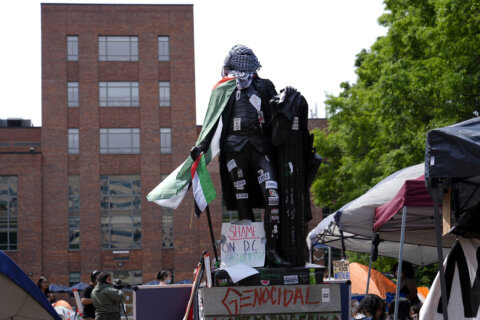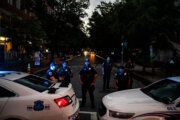The president of George Washington University has said it was a mistake to have posters on campus critical of the Chinese government taken down, but the artist who made the posters said that’s not nearly enough.
The posters play off the themes of the Beijing Olympics, depicting people in Chinese-flag uniforms pointing a rifle at a member of the Uyghur minority, skating over a Hong Kong flag, pushing a virus across the ice and more.
GW President Mark Wrighton said in a statement on Monday that he reacted “hastily” to reports that the posters promoted racism against Chinese.
“Upon full understanding, I do not view these posters as racist; they are political statements,” Wrighton said. “There is no university investigation underway, and the university will not take any action against the students who displayed the posters.”
Baducaio, the Chinese-Australian artist who created the posters, told WTOP Wrighton’s statement was a “PR management response to this incident instead of a truly [sincere] apology.”
He said he created the art several months ago “for protesting and boycotting the Beijing Olympics. And for each design, it is clearly depicting a human rights violation from the Chinese government. So those posters are the reminder to the people who are going to attending watching Olympic that Chinese government has made many, many crimes against humanity.”
The complaints about the posters, Baducaio said, didn’t come as a surprise. He said they came from “student groups who are affiliated with the Chinese government … calling my art anti-China, or racism, because this has been the tactic and strategy to diminish or cancel legitimized criticism against Chinese government.”
He called it “really a shock” that Wrighton had taken such offense to his art: “I’m shocked at how … a top U.S. university president couldn’t understand the meaning of those posters, because those are not high art. Those are posters. It’s like political cartoons.”
Soon, Baducaio said, said that shock gave way to suspicion. The university leadership, he said, “compromised on its very job to defend freedom of speech in its campus,” and he thinks influence from the Chinese government — “financial aspects as well as political aspects” — had something to do with the removal of his art.
‘Disappointing’
“Official Chinese students associations abroad often have close ties to China’s embassies and consulates, which often provide funding to the groups and sometimes ask them to hold pro-Chinese Communist Party political activities,” Axios reported.
Maya Wang, of Human Rights Watch, told Axios: “Racism and discrimination against people of Chinese origin is definitely real. But some are exploiting this legitimate grievance and twisting it to say that any criticism of China is racism against Chinese people and should not be raised in any form.”
She also called the university response “disappointing,” because it seemed to assume that official Chinese student associations are representative.
“I know of many Chinese students in the U.S. who are afraid of these Chinese student associations,” Wang said.
Baducaio said that the damage has been done to freedom of speech, saying that Chinese students in the U.S. who are fighting for change and putting up his artwork are afraid of reprisal from the Chinese government.
He also noted that Wrighton didn’t say the posters would be put back up.
“The university who took down the poster should be the university who put back the poster as well,” Baducaio said.
“I will be very happy to facilitate for a more permanent display of my art, not for my personal gain or anything, but just so that my art could spark more discussion around those topics,” among American students who don’t know much about the situation in China as well as Chinese students who have a different view from the government.
WTOP’s Matt Small contributed to this report.








